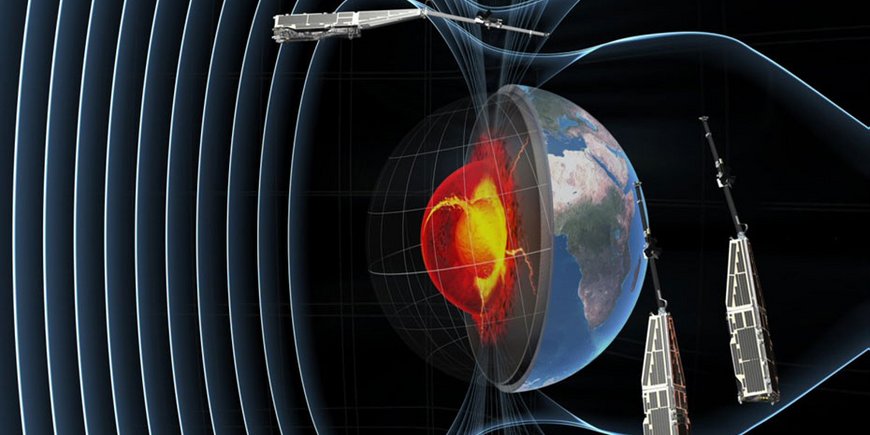03.12.2013|Potsdam: With the launch of the three ESA satellites SWARM on 22 Oct. 2013 using a Russian Rockot, the subsequent injection of the satellites into orbit and the establishment of radio contact with the three satellites, one and a half hours later, the start of this mission was successfully accomplished.
The next critical step consisted of the deployment of the boom, which carries the highly sensitive magnetometers and the star trackers: a few hours later this process was confirmed: the unfolding mechanism functioned perfectly in the case of all three satellites.
As the European Space Agency ESA and the satellite producer Astrium announced in a status report on Wednesday 3 Dec. 2013, all scientific instruments could be switched into operation during the ensuing passages over the ground station Kiruna, Sweden.
On the tip of the 4-meter boom of each satellite a magnetometer is positioned for measuring the strength of the magnetic field. A vector-magnetometer for measurement of the magnetic field direction and a set of three star cameras for the spatial orientation of the satellites are installed respectively at the centre of the boom. An accelerometer measures the forces affecting the satellite; an electric field instrument registers the dynamics of the ions in the upper atmosphere as well as the density and temperature of the surrounding plasma. An important instrument for the scientific interpretation of the measured data is the GPS receiver. This allows for determination of the satellite’s position and the exact time. And not to be forgotten is the special mirror system on the lower side of the satellites. It serves as a reflector for the laser-pulses sent out from ground stations. In this way the satellite orbit can be determined exactly to the millimeter.
As ESA reported, all six instruments on each of the three satellites have successfully gone into operation. Merely the device for measurement of the electric field is still operating without the scheduled activation of the high voltage, as this instrument requires additional time for a complete outgassing. In the coming week and up to the end of February the in-orbit calibration of the system will take place and will be followed by the fine tuning of the measurement modes of the individual instruments. The GFZ with its experience from CHAMP and GRACE missions is involved in this task. In addition the laser retro-flectors provided by GFZ have been able to prove their quality. Already during the first experiments distance measurements with an uncertainty of only 8 mm could be achieved. The cloudy autumn weather at the GFZ station in Potsdam has, however, led to less frequent measurement opportunities up to now.








![[Translate to English:] Torsten Sachs in front of a climate station on a field](/fileadmin/_processed_/3/9/csm__TorstenSachs_bearbeitet_GS_4a1365ef84.jpeg)

![[Translate to English:] left image flood at the Ahrtal: image from above, several houses are flooded; left image:: Heidi Kreibich;](/fileadmin/_processed_/4/4/csm_Bild2_9af0130e9f.png)



![[Translate to English:] Start der Vega Rakete](/fileadmin/_processed_/6/4/csm_20231201-kachel_Vega-VV23-launch_ESA-CNES-Arianespace_706716b68c.jpeg)









![[Translate to English:] Poster exhibition at the Brandenburg Hydrogen Day at the GFZ, some participants in the foreground](/fileadmin/_processed_/6/5/csm_Erster_Brandenburgischer_Wasserstofftag_GFZ_402fcec95e.jpeg)
![[Translate to English:] Group picture of the participants](/fileadmin/_processed_/9/4/csm_20231108_CAWa-Workshop-Tashkent_Gruppenbild_99ea779d8a.jpeg)

![[Translate to English:] [Translate to English:] Hörsaal](/fileadmin/_processed_/e/6/csm_H%C3%B6rsal_e21ac645fb.jpeg)


![[Translate to English:] The Delegations in the Historic Library on the Telegrafenberg. In the back there are from left to right, the Dutch Ambassador for Germany, Ronald van Roeden, the Dutch Minister for Education, Culture and Science, Robbert Dijkgraaf and the scientific director of the GFZ, Susanne Buiter.](/fileadmin/_processed_/d/b/csm_Kachel-2_9eba4b4212.jpeg)

